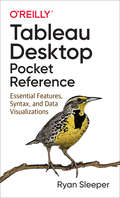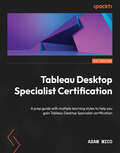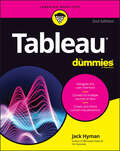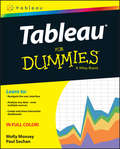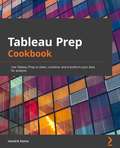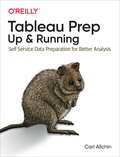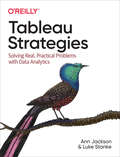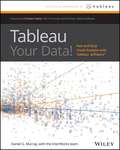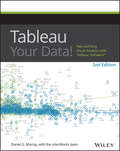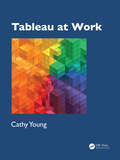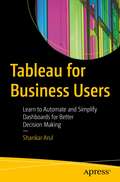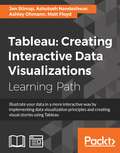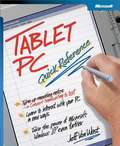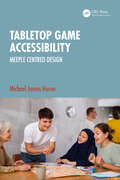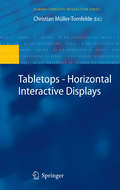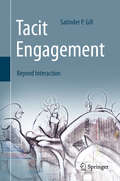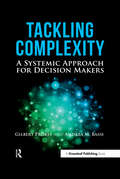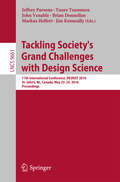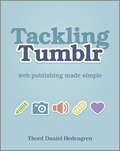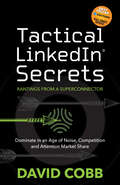- Table View
- List View
Tableau Desktop Cookbook: Quick & Simple Recipes to Help You Navigate Tableau Desktop
by Lorna BrownWhether you're a beginner just learning how to create data visualizations or a Jedi who's already used Tableau for years, this cookbook has a recipe for everyone. Author Lorna Brown provides more than 100 practical recipes to enhance the way you build Tableau dashboards--and helps you understand your data through the power of Tableau Desktop's interactive datavisualizations.With this cookbook, Tableau beginners will learn hands-on how this unique self-serve tool works, while experienced users will find this book to be an ideal reference guide on how to employ specific techniques. It also links you to online resources and community features, such as Tableau Tip Tuesday and Workout Wednesday. By the time you reach the end, you'll be a competent user of Tableau Desktop.You'll learn how to:Build both basic and complex data visualizations with Tableau DesktopGain hands-on experience with Tableau's latest features, including set and parameter actionsCreate interactive dashboards to support business questionsImprove your analytical skills to enhance the visualizations you've already createdLearn data visualization skills and best practices to help you and your organization
Tableau Desktop Pocket Reference: Essential Features, Syntax, and Data Visualizations
by Ryan SleeperIn a crowded field of data visualization and analytics tools, Tableau Desktop has emerged as the clear leader. This is partly due to its ease of use, but once you dive into Tableau's extensive feature set, you'll understand just how powerful and flexible this software can be for your business or organization.With this handy pocket reference, author Ryan Sleeper (Innovative Tableau) shows you how to translate the vast amounts of data into useful information. Tableau has done an amazing job of making valuable insights accessible to analysts and executives who would otherwise need to rely on IT. This book quickly guides you through Tableau Desktop's learning curve.You'll learn:How to shape data for use with Tableau DesktopHow to create the most effective chart typesCore concepts including discrete versus continuousMust-know technical features including filters, parameters, and setsKey syntax for creating the most useful analysesHow to bring it all together with dashboardsAnd more!
Tableau Desktop Specialist Certification: A prep guide with multiple learning styles to help you gain Tableau Desktop Specialist certification
by Adam MicoMaster Tableau fundamentals and get the one and only Tableau certification that never expires, while expediting your journey from zero to certificationKey FeaturesLearn how Tableau works inside and out for basic as well as intermediate uses of the applicationGain knowledge from a Tableau visionary and ambassador who successfully passed the examination in 2021Understand what is needed to pass a knowledge-based examination without having to use Tableau in the processBook DescriptionThe Tableau Desktop Specialist certification is fundamental for any data visualization professional who works in the field with Tableau.This book gets you started by covering the exam format, Tableau basics, and best practices for preparing data for analysis and visualization. It also builds on your knowledge of advanced Tableau topics to get you up to speed with the essential domains and domain objectives. Although the guide provides an outline and starting point to key in on what needs to be understood before the examination, it also delivers in context to give you a strong understanding of each piece before taking the exam. Instructions on how to get hands on with examples, a common data source, and suggested elements are also included. Understanding the concepts will not only assist you in passing the examination, but will also help you work effectively with the tool in your workspace.By the end of this book, you'll be able to efficiently prepare for the certification exam with the help of mock tests, detailed explanations, and expert advice from the author.What you will learnUnderstand how to add data to the applicationExplore data for insights in TableauDiscover what charts to use when visualizing for audiencesUnderstand functions, calculations and the basics of parametersWork with dimensions, measures and their variationsContextualize a visualization with marksShare insights and focus on editing a Tableau visualizationWho this book is forIf you're a data analyst, data scientist, or if you just want to enhance your data visualization tool stack, this book is for you. It's designed for those without prior and those with minimal exposure to Tableau, which also means it's useful for anyone moving into their first role that relies on data visualization.
Tableau For Dummies
by Jack A. HymanDiscover how visualization turns data into action Tableau gives you the power to understand your data and put it in a format that is appealing and meaningful for everyone who needs to see it. Tableau For Dummies walks you through the steps to turn your data into a story that inspires action. This easy-to-understand guide offers insights from an enterprise data pro on how to transform data into a clear and memorable visual presentation. Navigate the Tableau user interface and connect to data sources Use drag-and-drop features to create stunning visualizations Work with templates, add graphs, and create clear charts Export your visualizations to multiple formats for easy sharingThis is the perfect Dummies software guide for business professionals who need to better derive value from that all-important data.
Tableau For Dummies
by Molly Monsey Paul SochanMake your data work for you! Tableau For Dummies brings order to the chaotic world of data. Understanding your data and organizing it into formats and visualizations that make sense to you are crucial to making a real impact on your business with the information that's already at your fingertips. This easy-to-use reference explores the user interface, and guides you through the process of connecting your data sources to the software. Additionally, this approachable, yet comprehensive text shows you how to use graphs, charts, and other images to bring visual interest to your data, how to create dashboards from multiple data sources, and how to export the visualizations that you have developed into multiple formats that translate into positive change for your business. The mission of Tableau Software is to grant you access to data that, when put into action, will help you build your company. Learning to use the data available to you helps you make informed, grounded business decisions that can spell success for your company. Navigate the user interface to efficiently access the features you need Connect to various spreadsheets, databases, and other data sources to create a multi-dimensional snapshot of your business Develop visualizations with easy to use drag and drop features Start building your data with templates and sample workbooks to spark your creativity and help you organize your information Tableau For Dummies is a step-by-step resource that helps you make sense of the data landscape--and put your data to work in support of your business.
Tableau Prep Cookbook: Use Tableau Prep to clean, combine, and transform your data for analysis
by Hendrik KleineExplore common and not-so-common data transformation scenarios and solutions to become well-versed with Tableau Prep and create efficient and powerful data pipelinesKey FeaturesCombine, clean, and shape data for analysis using self-service data preparation techniquesBecome proficient with Tableau Prep for building and managing data flows across your organizationLearn how to combine multiple data transformations in order to build a robust datasetBook DescriptionTableau Prep is a tool in the Tableau software suite, created specifically to develop data pipelines. This book will describe, in detail, a variety of scenarios that you can apply in your environment for developing, publishing, and maintaining complex Extract, Transform and Load (ETL) data pipelines. The book starts by showing you how to set up Tableau Prep Builder. You'll learn how to obtain data from various data sources, including files, databases, and Tableau Extracts. Next, the book demonstrates how to perform data cleaning and data aggregation in Tableau Prep Builder. You'll also gain an understanding of Tableau Prep Builder and how you can leverage it to create data pipelines that prepare your data for downstream analytics processes, including reporting and dashboard creation in Tableau. As part of a Tableau Prep flow, you'll also explore how to use R and Python to implement data science components inside a data pipeline. In the final chapter, you'll apply the knowledge you've gained to build two use cases from scratch, including a data flow for a retail store to prepare a robust dataset using multiple disparate sources and a data flow for a call center to perform ad hoc data analysis. By the end of this book, you'll be able to create, run, and publish Tableau Prep flows and implement solutions to common problems in data pipelines.What you will learnPerform data cleaning and preparation techniques for advanced data analysisUnderstand how to combine multiple disparate datasetsPrepare data for different Business Intelligence (BI) toolsApply Tableau Prep's calculation language to create powerful calculationsUse Tableau Prep for ad hoc data analysis and data science flowsDeploy Tableau Prep flows to Tableau Server and Tableau OnlineWho this book is forThis book is for business intelligence professionals, data analysts, and Tableau users looking to learn Tableau Prep essentials and create data pipelines or ETL processes using it. Beginner-level knowledge of data management will be beneficial to understand the concepts covered in this Tableau cookbook more effectively.
Tableau Prep: Self-service Data Preparation For Better Analysis
by Carl AllchinFor self-service data preparation, Tableau Prep is relatively easy to use—as long as you know how to clean and organize your datasets. Carl Allchin, from The Information Lab in London, gets you up to speed on Tableau Prep through a series of practical lessons that include methods for preparing, cleaning, automating, organizing, and outputting your datasets.Based on Allchin’s popular blog, Preppin’ Data, this practical guide takes you step-by-step through Tableau Prep’s fundamentals. Self-service data preparation reduces the time it takes to complete data projects and improves the quality of your analyses. Discover how Tableau Prep helps you access your data and turn it into valuable information.Know what to look for when you prepare dataLearn which Tableau Prep functions to use when working with data fieldsAnalyze the shape and profile of your datasetOutput data for analysis and learn how Tableau Prep automates your workflowLearn how to clean your dataset using Tableau Prep functionsExplore ways to use Tableau Prep techniques in real-world scenariosMake your data available to others by managing and documenting the output
Tableau Strategies: Solving Real, Practical Problems with Data Analytics
by Ann Jackson Luke StankeIf you want to increase Tableau's value to your organization, this practical book has your back. Authors Ann Jackson and Luke Stanke guide data analysts through strategies for solving real-world analytics problems using Tableau. Starting with the basics and building toward advanced topics such as multidimensional analysis and user experience, you'll explore pragmatic and creative examples that you can apply to your own data.Staying competitive today requires the ability to quickly analyze and visualize data and make data-driven decisions. With this guide, data practitioners and leaders alike will learn strategies for building compelling and purposeful visualizations, dashboards, and data products. Every chapter contains the why behind the solution and the technical knowledge you need to make it work.Use this book as a high-value on-the-job reference guide to TableauVisualize different data types and tackle specific data challengesCreate compelling data visualizations, dashboards, and data productsLearn how to generate industry-specific analyticsExplore categorical and quantitative analysis and comparisonsUnderstand geospatial, dynamic, statistical, and multivariate analysisCommunicate the value of the Tableau platform to your team and to stakeholders
Tableau Your Data!
by Dan MurrayBest practices and step-by-step instructions for using the Tableau Software toolsetAlthough the Tableau Desktop interface is relatively intuitive, this book goes beyond the simple mechanics of the interface to show best practices for creating effective visualizations for specific business intelligence objectives. It illustrates little-known features and techniques for getting the most from the Tableau toolset, supporting the needs of the business analysts who use the product as well as the data and IT managers who support it.This comprehensive guide covers the core feature set for data analytics, illustrating best practices for creating and sharing specific types of dynamic data visualizations. Featuring a helpful full-color layout, the book covers analyzing data with Tableau Desktop, sharing information with Tableau Server, understanding Tableau functions and calculations, and Use Cases for Tableau Software. Includes little-known, as well as more advanced features and techniques, using detailed, real-world case studies that the author has developed as part of his consulting and training practiceExplains why and how Tableau differs from traditional business information analysis toolsShows you how to deploy dashboards and visualizations throughout the enterpriseProvides a detailed reference resource that is aimed at users of all skill levelsDepicts ways to leverage Tableau across the value chain in the enterprise through case studies that target common business requirementsEndorsed by Tableau SoftwareTableau Your Data shows you how to build dynamic, best-of-breed visualizations using the Tableau Software toolset.
Tableau Your Data!
by Daniel G. MurrayTransform your organization's data into actionable insights with Tableau Tableau is designed specifically to provide fast and easy visual analytics. The intuitive drag-and-drop interface helps you create interactive reports, dashboards, and visualizations, all without any special or advanced training. This all new edition of Tableau Your Data! is your Tableau companion, helping you get the most out of this invaluable business toolset.Tableau Your Data! shows you how to build dynamic, best of breed visualizations using the Tableau Software toolset. This comprehensive guide covers the core feature set for data analytics, and provides clear step-by-step guidance toward best practices and advanced techniques that go way beyond the user manual. You'll learn how Tableau is different from traditional business information analysis tools, and how to navigate your way around the Tableau 9.0 desktop before delving into functions and calculations, as well as sharing with the Tableau Server. Analyze data more effectively with Tableau Desktop Customize Tableau's settings for your organization's needs with detailed real-world examples on data security, scaling, syntax, and more Deploy visualizations to consumers throughout the enterprise - from sales to marketing, operations to finance, and beyond Understand Tableau functions and calculations and leverage Tableau across every link in the value chain Learn from actual working models of the book's visualizations and other web-based resources via a companion website Tableau helps you unlock the stories within the numbers, and Tableau Your Data! puts the software's full functionality right at your fingertips.
Tableau at Work
by Cathy YoungWith data and AI increasingly at the forefront of business today, you have a significant advantage when you can manage data, and uncover and communicate data insights effectively. By thoroughly cataloging, indexing, and cross-referencing material, this book flattens the steep Tableau learning curve, starting you on your data journey and serving as a comprehensive reference and study guide. Where do I start with Tableau? How do I prepare and connect to data files that are constantly changing? How do I share Tableau files with co-workers, and what is tall data? How do I test whether the calculations and aggregations are correct? How can I create vibrant charts with sorting, color, axis labels, annotations, mark labels, trend lines, tooltips, or reference lines? The book includes over 60 worksheets and guides to deliver 40 quality charts and dashboards. In addition, there are another 60 focused and on-point examples, covering everything from context filters and weighted average calculations to transparent shapes and colors with placeholder fields. Similarly, nine step-by-step dashboard guides illustrate parameters, containers, buttons, actions, and more. With over 800 diagrams and images, clear explanations are provided for concepts including: Measures and Dimensions; Discrete vs. Continuous; Aggregation; Joins, Blends, and Relationships; Order of Operations; Mark Types and Color, Size, Text, Detail, and Tooltip Tiles; Actions, Sets, Links, Highlighting, and Parameters; Reference Lines and Trend Lines; Dashboard Layout, Containers, Filtering, and Interactivity.Tableau at Work is the perfect book for anyone who wants a comprehensive guide and reference to Tableau, from beginners and novices all the way to advanced and professional users. Many of the Tableau workbooks can be downloaded from the author’s Tableau Public profile and for more information you can also visit the author's website (www.TableauAtWork.com).
Tableau for Business Users: Learn to Automate and Simplify Dashboards for Better Decision Making
by Shankar ArulLearn Tableau by working through concrete examples and issues that you are likely to face in your day-to-day work. Author Shankar Arul starts by teaching you the fundamentals of data analytics before moving on to the core concepts of Tableau. You will learn how to create calculated fields, and about the currently available calculation functionalities in Tableau, including Basic Expressions, Level of Detail (LOD) Expressions, and Table Calculations. As the book progresses, you’ll be walked through comparisons and trend calculations using tables. A concluding chapter on dashboarding will show you how to build actionable dashboards to communicate analysis and visualizations. You’ll also see how Tableau can complement and communicate with Excel. After completing this book, you will be ready to tackle the challenges of data analytics using Tableau without getting bogged down by the technicalities of the tool. What Will You Learn Master the core concepts of Tableau Automate and simplify dashboards to help business users Understand the basics of data visualization techniques Leverage powerful features such as parameters, table calculations, level of detail expressions, and more Who is This book For Business analysts, data analysts, as well as financial analysts.
Tableau: Creating Interactive Data Visualizations
by Matt Floyd Ashutosh Nandeshwar Jen Stirrup Ashley OhmannIllustrate your data in a more interactive way by implementing data visualization principles and creating visual stories using Tableau About This Book * Use data visualization principles to help you to design dashboards that enlighten and support business decisions * Integrate your data to provide mashed-up dashboards * Connect to various data sources and understand what data is appropriate for Tableau Public * Understand chart types and when to use specific chart types with different types of data Who This Book Is For Data scientists who have just started using Tableau and want to build on the skills using practical examples. Familiarity with previous versions of Tableau will be helpful, but not necessary. What You Will Learn * Customize your designs to meet the needs of your business using Tableau * Use Tableau to prototype, develop, and deploy the final dashboard * Create filled maps and use any shape file * Discover features of Tableau Public, from basic to advanced * Build geographic maps to bring context to data * Create filters and actions to allow greater interactivity to Tableau Public visualizations and dashboards * Publish and embed Tableau visualizations and dashboards in articles In Detail With increasing interest for data visualization in the media, businesses are looking to create effective dashboards that engage as well as communicate the truth of data. Tableau makes data accessible to everyone, and is a great way of sharing enterprise dashboards across the business. Tableau is a revolutionary toolkit that lets you simply and effectively create high-quality data visualizations. This course starts with making you familiar with its features and enable you to develop and enhance your dashboard skills, starting with an overview of what dashboard is, followed by how you can collect data using various mathematical formulas. Next, you'll learn to filter and group data, as well as how to use various functions to present the data in an appealing and accurate way. In the first module, you will learn how to use the key advanced string functions to play with data and images. You will be walked through the various features of Tableau including dual axes, scatterplot matrices, heat maps, and sizing.In the second module, you'll start with getting your data into Tableau, move onto generating progressively complex graphics, and end with the finishing touches and packaging your work for distribution. This module is filled with practical examples to help you create filled maps, use custom markers, add slider selectors, and create dashboards. You will learn how to manipulate data in various ways by applying various filters, logic, and calculating various aggregate measures. Finally, in the third module, you learn about Tableau Public using which allows readers to explore data associations in multiple-sourced public data, and uses state-of-the-art dashboard and chart graphics to immerse the users in an interactive experience. In this module, the readers can quickly gain confidence in understanding and expanding their visualization, creation knowledge, and quickly create interesting, interactive data visualizations to bring a richness and vibrancy to complex articles. The course provides a great overview for beginner to intermediate Tableau users, and covers the creation of data visualizations of varying complexities. Style and approach The approach will be a combined perspective, wherein we start by performing some basic recipes and move on to some advanced ones. Finally, we perform some advanced analytics and create appealing and insightful data stories using Tableau Public in a step-by-step manner.
Tablet PC Quick Reference
by Jeff Van WestWhether you're in a meeting, hallway, coffee shop, or conference--achieve ultimate mobility with the TABLET PC QUICK REFERENCE. Combining the simplicity of pen and paper with all the muscle of Microsoft® Windows® XP Professional, the Tablet PC is more than just cool--it can maximize your productivity, no matter how or where you work. Use this expert guide to get up and running faster, and take the power of a desktop PC--and more--anywhere you'd take a notepad and pen! Pen, voice, keyboard, mouse--you decide how to control your Tablet PC Accelerate your dexterity with the digital pen, Input Panel, and Windows Journal Save, edit, search, and e-mail your handwritten notes Add notes and drawings directly into Microsoft Word documents, Microsoft Excel spreadsheets, and other digital documents Annotate Microsoft PowerPoint® slides--even as you present them Go hands-free with voice commands and dictation capabilities See how the Tablet can maximize collaboration and interactivity in meetings
Tablet PC Quick Reference
by Microsoft Corporation<div xmlns="http://www.w3.org/1999/xhtml"><p>In a meeting, in the hallway, or on the run\u2014achieve ultimate mobility with the TABLET PC QUICK REFERENCE. This expert guide shows how to get up and running faster with the Tablet\u2019s digital pen, Input Panel, Windows\xae Journal, speech recognition, and more.</p></div>
Tabletop Game Accessibility: Meeple Centred Design
by Michael James HeronThis foundational resource on the topic of tabletop game accessibility provides actionable guidelines on how to make games accessible for people with disabilities. This book contextualises this practical guidance within a philosophical framework of how the relatively abled can ethically address accessibility issues within game design.This book helps readers to build understanding and empathy across the various categories of accessibility. Chapters on each category introduce ‘the science’, outline the game mechanics and games that show exemplar problems, relate these to the real-world situations that every player may encounter, and then discuss how to create maximally accessible games with reference to the accessibility guidelines and specific games that show ‘best-in-class’ examples of solutions.This book will be of great interest to all professional tabletop and board game designers as well as digital game designers and designers of other physical products.
Tabletop Game Design for Video Game Designers
by Ethan Ham<p>Learn the mechanics that take your game from an idea to a playable product. <p>Do you aspire to be a game designer but aren’t sure where to begin? Tabletop Game Design for Video Game Designers guides you through your initial attempts to design game mechanics. It goes beyond simple description and definition to explore in detail the issues that designers grapple with for every game they create. <p>Learning to design tabletop games builds a solid foundation for game designers and provides methods that can be applied towards creating paper prototypes of computer-targeted games. Presented in a step-by-step format, Tabletop Game Design for Video Game Designers helps the reader understand how the game design skills that are acquired through creating tabletop games can be used when designing video games. Fully playable games accompany every topic so you can truly understand and experience each component that goes into game creation. <p>Tabletop Game Design for Video Game Designers includes: <p> <li>Simple, highly focused games that can be played, analyzed, improved, and/or modified in conjunction with a particular topic in the book. <li>Integrated game design exercises, chapter learning objectives, and in-text sidebars to provide further examples to apply directly to your game creation process. <li>A companion website (www.funmines.com) which includes: "print & play" tabletop games, links to online games, game design resources, and articles about designing and developing games.</li> </p>
Tabletop Photography
by Cyrill HarnischmacherImagine capturing stunning, professional-looking product shots without needing a studio filled with expensive equipment and large flash units. This book teaches all the steps for creating your own tabletop photography studio. Affordable compact flashes offer a number of creative lighting options within your tabletop studio; and the appropriate lighting and backdrop, and the creative use of your camera's features are key to a perfect image. Author Cyrill Harnischmacher guides you through a variety of exposure and lighting techniques, and covers how to achieve excellent results using compact flash units. Whether you wish to capture product images for use in print or on the web, or you want to improve your photos for personal use, this book will provide you with everything you need to know to get great results. Topics include: Lighting Setups; Reflectors, Diffusors, and Accessories; Soft Boxes and Umbrellas; Strobe Flashes; Combining Long Exposures with Flashlights; Multi-Flash Exposures; Composition and Arrangements; Creating Backdrops; Product Photography; Smoke, Fog, and Special Effects; Food Photography and much more...
Tabletops - Horizontal Interactive Displays
by Christian Müller-TomfeldeThis book is the first attempt to bring together current research findings in the domain of interactive horizontal displays. The novel compilation will integrate and summarise findings from the most important international tabletop research teams. It will provide a state-of-the art overview of this research domain and therefore allow for discussion of emerging and future directions in research and technology of interactive horizontal displays. Latest advances in interaction and software technologies and their increasing availability beyond research labs, refuels the interest in interactive horizontal displays. In the early 1990s Mark Weiser's vision of Ubiquitous Computing redefined the notion of Human Computer Interaction. Interaction was no longer considered to happen only with standard desktop computers but also with elements of their environment. This book is structured in three major areas: 'under', 'on/above' and 'around' tabletops. These areas are associated with different research disciplines such as Hardware/Software and Computer Science, Human Computer Interaction (HCI) and Computer Supported Collaborative Work (CSCW). However, the comprehensive and compelling presentation of the topic of the book results from its interdisciplinary character. The book addresses fellow researchers who are interested in this domain and practitioners considering interactive tabletops in real-world projects. It will also be a useful introduction into tabletop research that can be used for the academic curriculum.
Tabular Modeling with SQL Server 2016 Analysis Services Cookbook
by Derek WilsonExpert tabular modeling techniques for building and deploying cutting-edge business analytical reporting solutions About This Book • Build and deploy Tabular Model projects from relational data sources • Leverage DAX and create high-performing calculated fields and measures • Create ad-hoc reports based on a Tabular Model solution • Useful tips to monitor and optimize your tabular solutions Who This Book Is For This book is for SQL BI professionals and Architects who want to exploit the full power of the new Tabular models in Analysis Services. Some knowledge of previous versions of Analysis services would be helpful but is not essential. What You Will Learn • Learn all about Tabular services mode and how it speeds up development • Build solutions using sample datasets • Explore built-in actions and transitions in SSAS 2016 • Implement row-column, and role-based security in a Tabular Data model • Realize the benefits of in-memory and DirectQuery deployment modes • Get up to date with the new features added to SQL Server 2016 Analysis Services • Optimize Data Models and Relationships Usage In Detail SQL Server Analysis Service (SSAS) has been widely used across multiple businesses to build smart online analytical reporting solutions. It includes two different types of modeling for analysis services: Tabular and Multi Dimensional. This book covers Tabular modeling, which uses tables and relationships with a fast in-memory engine to provide state of the art compression algorithms and query performance. The book begins by quickly taking you through the concepts required to model tabular data and set up the necessary tools and services. As you learn to create tabular models using tools such as Excel and Power View, you'll be shown various strategies to deploy your model on the server and choose a query mode (In-memory or DirectQuery) that best suits your reporting needs. You'll also learn how to implement key and newly introduced DAX functions to create calculated columns and measures for your model data. Last but not least, you'll be shown techniques that will help you administer and secure your BI implementation along with some widely used tips and tricks to optimize your reporting solution. By the end of this book, you'll have gained hands-on experience with the powerful new features that have been added to Tabular models in SSAS 2016 and you'll be able to improve user satisfaction with faster reports and analytical queries. Style and approach This book takes a practical, recipe-based approach where each recipe lists the steps to address or implement a solution. You will be provided with several approaches to creating a business intelligence semantic model using analysis services.
Tacit Engagement
by Satinder P. GillThis book explores how digital technology is altering the relationships between people and how the very nature of interface itself needs to be reconsidered to reflect this - how we can make sense of each other, handle ambiguities, negotiate differences, empathise and collectively make skilled judgments in our modern society. The author presents new directions for research at the relational-transactional intersection of contrasting disciplines of arts, science and technology, and in so doing, presents philosophical and artistic questions for future research on human connectivity in our digital age. The book presents frameworks and methods for conducting research and study of tacit engagement that includes ethnography, experiments, discourse analysis, gesture analysis, psycholinguistic analysis, artistic experiments, installations, and improvisation. Case studies illustrate the use of various methods and the application and emergence of frameworks. Tacit Engagement will be of interest to researchers, designers, teachers and students concerned with new media, social media and communications networks; interactive interfaces, including information systems, knowledge management, robotics, and presence technologies. Not since Michael Polanyi have we seen such wise science about the tacit: how we know more than we can tell. Gill brings to the present era of design and data a profoundly needed perspective on meaning that comes from social dialogue, skilled performance, relational gesture and rhythm. - Sha Xin Wei, Ph. D. (Synthesis, ASU)
Tackling Complexity: A Systemic Approach for Decision Makers
by Gilbert Probst Andrea BassiOur socio-economic systems continue to grow and evolve. We need to acknowledge that, consequently, our decisions often fail – they are ineffective and create unexpected side effects. The speed of execution is increasing constantly and markets and systems respond almost immediately, making decision-making challenging. There is little or no room for failure.This important new book analyses real world strategy and policy challenges, addressing the interconnectedness of the markets/systems we live in. It provides a step-by-step approach using systems thinking to solve complex problems in socio-political as well as business environment. It proposes a technique with which to better understand the problems and the context in which they arise, and tools to directly inform each step of the decision-making process. The book explores the main innovation that systemic thinking introduces – the emphasis on defining the problem creating system, which is made up of interacting parts, rather than prioritizing events that need immediate fixing.The case studies, examples and the approach proposed can be used to better understand reality and its complexity, and to integrate stakeholders for a better solution. Practically, it can be used to identify problems, analyse their boundaries, design interventions, forecast and measure their expected impacts, implement them and monitor and evaluate their success/failure. The book touches upon global issues related to policy making and strategic management, as well as issues related to sustainable development for both the public and private sector.
Tackling Society's Grand Challenges with Design Science
by Markus Helfert Jeffrey Parsons Tuure Tuunanen John Venable Brian Donnellan Jim KenneallyThis book constitutes the thoroughly refereed proceedings of the 11th International Conference on Design Science Research in Information Systems and Technology, DESRIST 2016, held in St. John, Newfoundland, Canada, in May 2016. The 11 full papers, 2 short papers and 9 short papers describing prototypes and products were carefully reviewed and selected from 54 submissions. The papers are organized around the following topics: methodological aspects of design science; applications of design science research to real world design problems, for example in social media, health care systems, embedded technologies, climate, security.
Tackling Tumblr
by Thord Daniel HedengrenA comprehensive guide to the popular web publishing site TumblrThe popularity of Tumblr is growing by leaps and bounds, as it continues to make a name for itself as a reliable, accessible blogging platform. Yet, there is very little documentation on Tumblr, leaving newcomers confused as to where to start. That's where this helpful book comes in. Written by well-respected author Thord Hedengren, this step-by-step guide is an ideal starting point for Tumblr newcomers as well as web designers who want to take their Tumblblogs to the next level. You'll learn how to maximize the full potential of this amazing blogging and lifestreaming platform as you create your first post, make your Tumblr blog unique, create your own custom themes, and more.Introduces you to the exciting world of Tumblr, the popular web publishing platformWalks you through posting quotes, links, photos, audio, and moreAddresses finding and installing themes, using a comment system on your Tumblr site, and integrating third-party contentDemonstrates how to create your own custom theme, network in the Tumblr community, and modify your Tumblr themes with HTML and CSSExplains ways to integrate Tumblr with other services, including Facebook, Twitter, and FlickrThere's no need to grumble about learning Tumblr--this book is all you need!
Tactical LinkedIn® Secrets: Rantings From a Superconnector: Dominate in an Age of Noise, Competition and Attention Market Share
by David CobbTactical LinkedIn® Secretsteaches business professionals how to dominate in an age of digital noise and competition.

